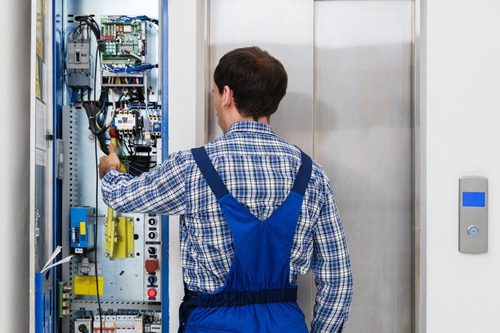Finest Lift Maintenance Company Options Near Me for Specialist Lift Repairs
Finest Lift Maintenance Company Options Near Me for Specialist Lift Repairs
Blog Article
Comprehensive Overview to Lift Equipments and Their Maintenance
Browsing the complex world of lift systems and their maintenance is a job that requires accuracy and expertise. From the various sorts of elevator systems being used to the careful adherence to safety laws, the upkeep of these vertical transportation tools is a complex undertaking. As buildings skyrocket higher and modern technology advancements, the demand for a detailed understanding of elevator systems becomes progressively vital. Join us as we unwind the complexities of elevator upkeep, discovering typical concerns, best techniques, and cutting-edge modern technologies that shape the modern-day landscape of upright transport.
Sorts Of Lift Equipments
The most common types include hydraulic elevators, traction elevators, machine-room-less elevators, and vacuum cleaner lifts. Hydraulic elevators are perfect for low-rise structures and make use of a hydraulic piston to move the lift auto. Machine-room-less lifts are a space-saving alternative as they do not call for a different machine space for the elevator machinery.
Each type of lift system has its very own benefits and disadvantages, making it crucial for building owners and programmers to thoroughly consider their specific needs before choosing one of the most appropriate option. Factors such as building height, room schedule, power performance, and budget plan restrictions all play a considerable role in identifying the ideal lift system for a specific building.
Typical Maintenance Problems
Routine maintenance of elevator systems is vital to make certain smooth operation and extend their life expectancy. In spite of normal upkeep, lift systems can still come across common maintenance issues that need to be immediately resolved to avoid disruptions in service. Among one of the most regular issues is door malfunctions. Elevator doors may obtain misaligned, resulting in issues with opening and closing properly. This can trigger hold-ups and safety and security hazards, requiring prompt attention from maintenance professionals. Another typical issue is connected to the lift's leveling precision. If the lift does not straighten properly with the floors, travelers may experience tripping hazards and pain. Furthermore, concerns with the control system, such as sensor issues or electrical issues, can create the lift to malfunction or quit functioning entirely. Normal inspections and aggressive upkeep can help recognize and deal with these typical upkeep concerns before they intensify and affect the general efficiency of the lift system.
Safety Regulations and Compliance
Abiding by stringent safety guidelines and guaranteeing conformity with sector criteria are critical for maintaining the operational stability of elevator systems. Elevators are subject to an extensive collection of safety policies to protect travelers, maintenance workers, and the general public. Governing bodies such as the Occupational Safety and Health And Wellness Administration (OSHA) in official source the United States and the European Lift Association (ELA) in Europe establish standards that cover numerous aspects of lift design, installment, maintenance, and operation.
Compliance with these policies is not only a lawful need however likewise an ethical commitment for building owners and elevator maintenance companies. Failing to fulfill safety requirements can result in penalties, lawful responsibilities, and, most significantly, jeopardize the security of individuals utilizing the lift. Normal assessments, maintenance checks, and adherence to safety protocols outlined in the guidelines are important to guarantee the effective and safe procedure of lift systems. By focusing on security policies and compliance, stakeholders can promote the trust fund of the public and minimize prospective threats connected with elevator usage.
Finest Practices for Upkeep

Building proprietors need to additionally think about investing in innovation upgrades to boost the efficiency and safety and security of their lift systems. By complying with these finest methods, lift systems can operate smoothly and securely, giving dependable upright transport for residents.

Advanced Technologies for Efficiency
Executing cutting-edge technologies in lift systems can dramatically improve operational efficiency and traveler experience. These systems allow travelers to input their preferred flooring prior to entering the elevator, which after that guides them to the most reliable car.
Furthermore, the combination of wise sensors and anticipating maintenance capabilities has revolutionized elevator upkeep. These sensors can find prospective problems prior to they rise, making it possible for proactive maintenance interventions and minimizing downtime. In addition, the use of energy-efficient parts and regenerative drives helps in reducing power intake and operating expense in elevator systems.
Furthermore, the application of cloud-based monitoring and remote diagnostics enables real-time tracking of elevator efficiency and prompt troubleshooting of useful site any type of malfunctions. This aggressive technique not just improves system reliability yet likewise enhances the total individual experience by ensuring smooth and continuous elevator operations.
Conclusion
In final thought, understanding the various sorts of lift systems, typical maintenance problems, security regulations, finest upkeep practices, and advanced modern technologies for efficiency is essential for making certain the smooth operation of elevators. By adhering to safety regulations and executing finest methods for maintenance, building proprietors can lengthen the life expectancy of their lift systems and ensure the safety of guests. It is vital to remain upgraded on the most recent innovations in elevator technology to boost effectiveness and reliability.
The most typical types consist of hydraulic lifts, grip elevators, machine-room-less elevators, and vacuum lifts. Hydraulic lifts are suitable for low-rise buildings and utilize a hydraulic piston to relocate the lift car. Machine-room-less elevators are a space-saving choice as they do not need a separate equipment area for the elevator machinery. Regular examinations and proactive upkeep can help recognize and resolve these check my blog common maintenance issues before they escalate and affect the general performance of the lift system.

Report this page